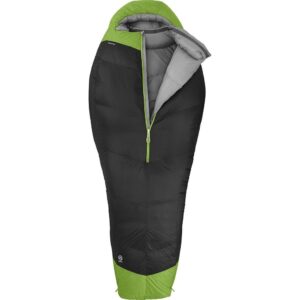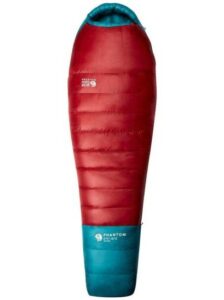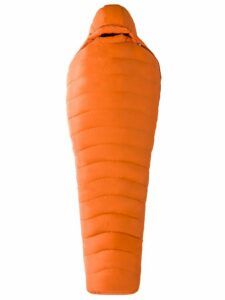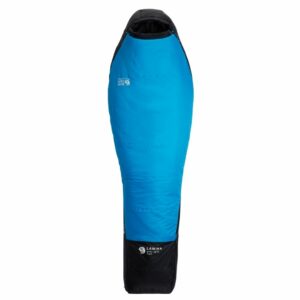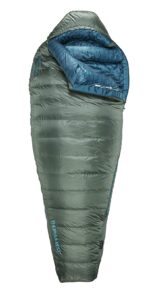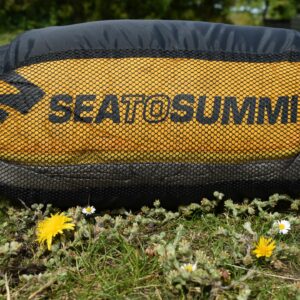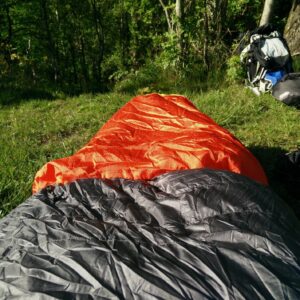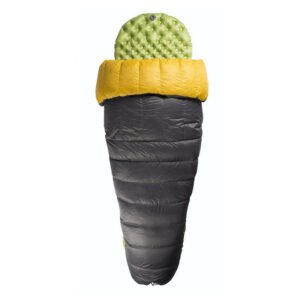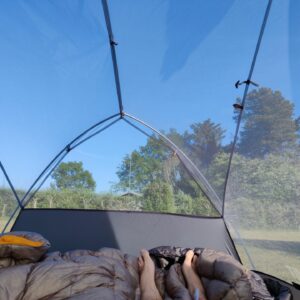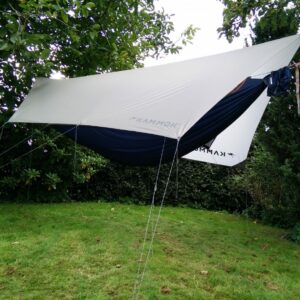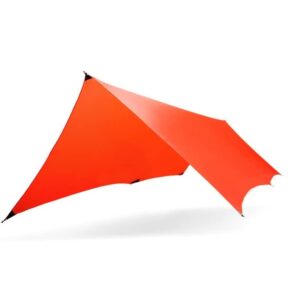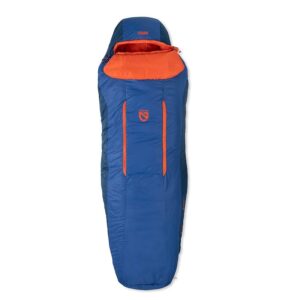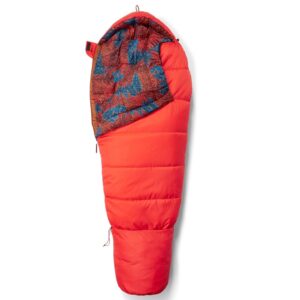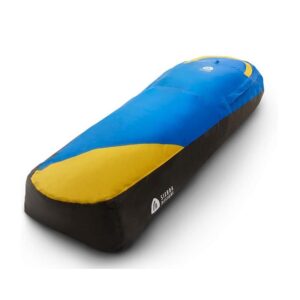Here we selected and reviewed the best winter sleeping bags for backpacking. A sleeping bag is probably the most important piece of sleeping equipment because it reduces the convective heat loss and thus keeps you warm and comfortable during nights. The warmth of a sleeping bag depends on the amount and quality of its insulation. High-quality winter sleeping bags use high-grade insulation (e.g. insulation with good warmth-to-weight ratio) and thus require a smaller amount of insulation to provide the same warmth as less sophisticated sleeping bags. Therefore, they are very light and pack down small which is indeed a big advantage. Note that lightweight equipment minimizes the strain on your body during activities such as backpacking, hiking, mountaineering etc.
The following is a selection and review of the best winter sleeping bags. We only listed high-quality sleeping bags which provide great comfort and a good warmth-to-weight ratio (they are light despite their superb insulation). Furthermore, all sleeping bags in this review pack down very small.
Updated Content
We regularly update our reviews and selections to always recommend you the best products on the market.
Expert Selections
We only list top-tier products. Read how our selections of best hiking products differ from others here.
Links
We use affiliate links and may receive a small commission on purchases at no extra cost to you.
1. Our Picks of Winter Sleeping Bags
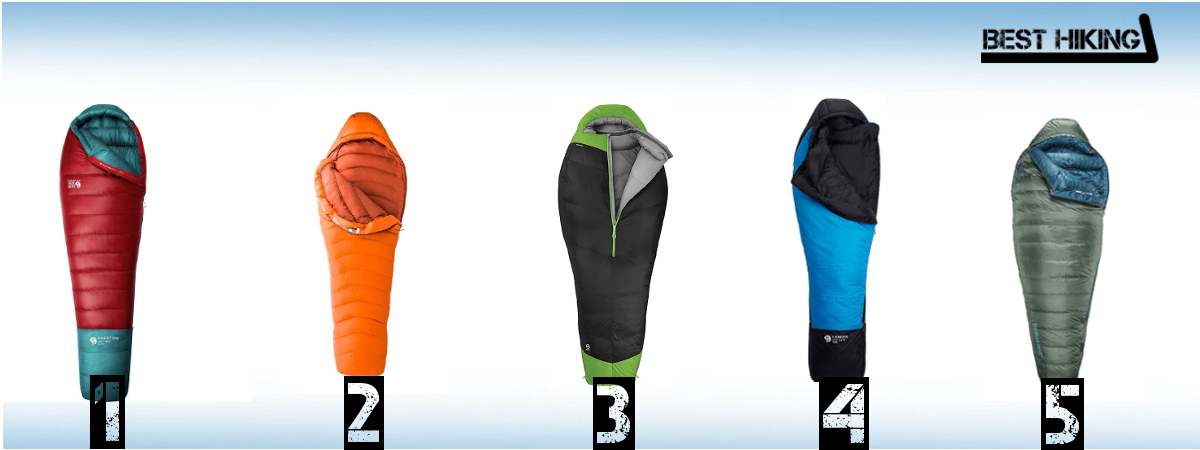
Best Winter Sleeping Bags
- Mountain Hardwear Phantom 0F Sleeping Bag
- Marmot Lithium Sleeping Bag
- The North Face Inferno 0 Sleeping Bag
- Mountain Hardwear Lamina 0
- Therm-a-Rest Questar 0
2. Comparison of Winter Sleeping Bags
| Feature/Product | Mountain Hardwear Phantom 0F | Marmot Lithium | The North Face Inferno | Mountain Hardwear Lamina 0 | Marmot Trestles Elite ECO 0 |
|---|---|---|---|---|---|
| Average Weight | 2 lbs. 11 oz. (Regular Size) | 2 lbs. 9.5 oz. (Regular Size) | 2 lbs. 14 oz (Regular Size) | 4 lbs. 3 oz. (Regular Size) | 2 lbs 11 oz (Regular Size) |
| Average Weight (Metric) | 1208 g (Regular Size) | 1176 g (Regular Size) | 1300 g (Regular Size) | 1890 g (Regular Size) | 1210 g (Regular Size) |
| Insulation Type | Down (850 Fill Power, DWR) | Down (800 Fill Power, DWR) | Down (800 Fill Power DWR) | Synthetic (Thermal Q) | Duck down (650 Fill, Nikwax DWR) |
| Face Fabric | 10-denier nylon | 20-denier nylon | n/a | 30-denier nylon | 20D Polyester |
| Packed Volume/Size | 8 in. x 16 in. (21 cm x 42 cm) | 9.8 liters | 23 liters | 9 in. x 18 in. (22 x 46 cm) | 8 in x 10 in (20 cm x 25 cm) |
| Lower Limit Rating | 0° F (-18° C) EN Standard | 0° F (-18° C) EN Standard | 0° F (-18° C) EN Standard | 0° F (-18° C) EN Standard | 0° F (-18° C) EN Standard |
| Comfort Temperature Rating | n/a | n/a | 13° F (-11° C) EN Standard | 16° F (-9° C) EN Standard | 14° F (-10° C) EN Standard |
3. The Selection
1. Mountain Hardwear Phantom 0F
Suitable for:
- Hiking
- Mountaineering
- Backpacking
- Climbing
- Camping
The Mountain Hardwear Phantom sleeping bag is very warm but at the same time super light. The sleeping bag has a lower limit rating of 0° F (-18° C) while it weighs merely 2.6 pounds (1208 g). Furthermore, the sleeping bag also packs down very small (it comes with a compression sack) and therefore takes up very little space in your backpack. The sleeping bag uses the cutting-edge Q.Shield down with a fill power index of 850. The Q.Shield down is also treated with DWR so that it repels the water rather than absorbing it. Therefore, it dries faster than regular down and retains more warmth if it gets wet or moist. The sleeping bag has also an insulated hood, ergonomic draft collar, insulated draft tube and a comfortable footbox. The draft collar prevents the body-warmed air from escaping to the outside while the insulated draft tube eliminates colds spots along the zipper. The sleeping bag is available in three sizes (regular, short and long) with left or right two-way zipper. The Mountain Hardwear Phantom sleeping bag is well-packable, super light and very warm; hands down the best product in this review. However, it is also the most expensive product listed here.
Pros:
- Weight
- Packs down very small
- DWR treated down
- Design
Cons:
- /
2. Marmot Lithium
Suitable for:
- Hiking
- Mountaineering
- Backpacking
- Climbing
- Camping
The Marmot Lithium sleeping bag is slightly warmer than the Mountain Hardwear sleeping bag listed above. Nevertheless, it weighs only a couple of grams more. The sleeping bag utilizes 800+ fill power goose down for insulation and has a face fabric made of Pertex Microlight material (20-denier ripstop nylon). The down insulation utilizes Marmot Down Defender technology – meaning that the down is treated with DWR to retain loft even when it is moist or wet. This also helps the sleeping bag to dry faster. The Marmot Lithium is equipped with two zippers; a two-way main zipper and a second zipper on the other side which is shorter and can be used for ventilation. Additionally, the sleeping bag features an insulated hood (with a draw cord), insulated draft tube, ergonomically designed footbox and two hang loops for drying. The sleeping bag packs down very small (less than 10 liters) and thus doesn’t take up too much space in a backpack.
Pros:
- Weight
- Packs down very small
- DWR treated down
- Hang loops for drying
Cons:
- /
3. The North Face Inferno 0
Suitable for:
- Hiking
- Mountaineering
- Backpacking
- Climbing
- Camping
The North Face Inferno sleeping bag is heavier and bigger (packed size) than the Marmot and Mountain Hardwear sleeping bags listed above while providing similar warmth. The sleeping bag is insulated with 800 fill power goose down (ProDown). The ProDown down is hydrophobic and thus it retains loft in highly humid environments and dries very fast. The North Face Inferno sleeping bag has a quite wide cut and thus allows you to wear more layers during the night. However, the wide cut also adds weight to the sleeping bag and makes it less packable. The sleeping bag also features a draft collar, insulated hood with a drawcord and an ergonomically designed footbox. On the hood, footbox and back it uses a water-resistant face fabric (Neovent Air) for better protection against the humidity. The sleeping bag has a half-length center zipper which gives you less ventilation options than a conventional ¾ side zipper that most sleeping bags use. The sleeping bag is available in four different versions (15F, 0F, -20F and -40F) which differ in temperature ratings.
Pros:
- DWR treated down
- Wide cut
- Warmth
Cons:
- Zipper
4. Mountain Hardwear Lamina 0
Suitable for:
- Hiking
- Mountaineering
- Backpacking
- Climbing
- Camping
The Mountain Hardwear Lamina 0 sleeping bag differs from the sleeping bags listed above by being insulated with synthetic insulation rather than down insulation. Therefore, it’s heavier and bigger (packed size) but also half the price. The Mountain Hardwear Lamina 0 sleeping bag uses Thermal Q synthetic insulation which mimics the structure of goose down and thus offers a surprisingly good warmth-to-weight ratio. The face fabric is made of 30-denier ripstop nylon to provide good abrasion resistance. It is also treated with DWR in order to repel water. The sleeping bag also features an ergonomic draft collar, comfortable footbox and an insulated hood. The Mountain Hardwear Lamina 0 is a great option for those who are planning to do backpacking trips in winter, but on a tight budget.
Pros:
- Price
- Design
- Retains warmth in very humid environments
- Durability
Cons:
- Weight
- Packed size
Where to buy?
Also available at:
5. Therm-a-Rest Questar 0
Suitable for:
- Hiking
- Mountaineering
- Backpacking
- Climbing
- Camping
The Therm-a-Rest Questar 0 is the cheapest winter sleeping bag with down insulation on this list, but that does not mean that it lacks in quality. It weighs the same as the Mountain Hardwear Phantom and Marmot sleeping bags above, but packs smaller as it uses Nikwax-treated hydrophobic duck down with the fill power of 650. Nevertheless, it has the same lower limit rating of 0 ⁰F (-18 ⁰C). The insulation is zoned, meaning that it is placed where you need it the most and the sleeping bag features a box baffled construction with mesh walls between the insulation sections so you avoid the cold spots which can occur with a stitched-through construction. In addition, the Therm-a-Rest Questar 0 features a draft collar, full-length zipper draft tube on the snag-free zipper, an external zip pocket, a cinchable hood help trap heat inside, and quilt and blanket loops as well as SynergyLink™ Connectors to combine the Therm-a-Rest sleeping bag with other pieces of sleeping gear.
Pros:
- Responsibly sourced (RDS-certified) DWR-treated down
- Weight
- Packs down very small
Cons:
- Might feel less warm due to lower down fill power compared to others
Where to buy?
Also available at:
4. Winter Sleeping Bag Buying Advice – What is important?
Insulation:
Sleeping bags are either insulated with down or synthetic insulation. Both insulation materials have advantages and disadvantages. Down insulation has a better warmth-to-weight ratio than synthetic insulation (smaller amount of insulation is required for the same warmth) and thus down sleeping bags are lighter and pack smaller. However, they are also much more expensive and lose their insulating properties quickly if they get wet or moist. To minimize this shortcoming, many manufacturers treat the down insulation with DWR (Durable Water Repellant) so that it retains decent warmth even if it gets wet/moist. The quality of down insulation is measured with the fill-power index which usually varies from 400 to 900. The higher the fill-power index, the better weight-to-warmth ratio the down insulation offers. To learn more about the insulation materials, check out the sleeping bags section in our Sleeping Equipment Guide.
In this review, we listed both down and synthetic sleeping bags. In general, we do recommend down sleeping bags for winter hiking as they are lighter and less bulky, but it makes sense to go for a synthetic sleeping bag if you are on a tight budget or you are planning to hike in areas where there is a high risk that the sleeping bag will get moist/wet.
Temperature Rating:
Temperature ratings of sleeping bags are often listed by the EN 13537 standard which consists of the following four parameters: Extreme temperature (an average woman will survive), lower limit (an average man will be comfortable), comfort temperature (an average woman will be comfortable) and maximum temperature (overheating limit). Nevertheless, it is often only the lower limit temperature which is listed. Note that some manufacturers use their own tests and standards. All sleeping bags in this review have a lower limit temperature of 0° F (-18° C) and a comfort temperature around 16° F (-9° C).
Size:
Sleeping bags typically come in two sizes; regular and long. The general rule of thumb is to go for size L if you are taller than 6 ft. (180 cm). However, you should always check the sizing to be sure that the sleeping bag will fit you comfortably.
Style:
There are several different styles of sleeping bags; mummy, quilt, wearable etc. In this review, we only included mummy sleeping bags as these offer the best insulation – they snugly enclose your body and head (usually with a draw cord at the neckline) thus preventing the body-warmed air from escaping to the outside.
5. Questions and Answers
What sleeping bag do I need for winter camping?
For winter camping we recommend using a winter sleeping bag which has a comfort temperature rating that matches the temperatures you are expecting to encounter. For example, if you are expecting temperature of 16° F (-9° C) we recommend a sleeping bag that has a comfort temperature rating of 16° F (-9° C) or less.
How are sleeping bags rated?
Sleeping bags are usually rated by the EN 13537 standard which is based on four different ratings; extreme temperature (an average woman will survive), lower limit (an average man will be comfortable), comfort temperature (an average woman will be comfortable) and maximum temperature (overheating limit). Low-grade sleeping bags are typically not rated by the EN 13537 standard.
What’s inside a sleeping bag?
Inside a sleeping bag is either down insulation or synthetic insulation. These fluffy insulations trap the body-warmed air and thus help you keep warm. Down insulation is more thermally efficient than synthetic insulation, but not suitable for very humid conditions because it quickly loses its warmth if it gets wet. Synthetic insulation is heavier for the warmth it offers than down, but provides warmth even if it gets wet.
